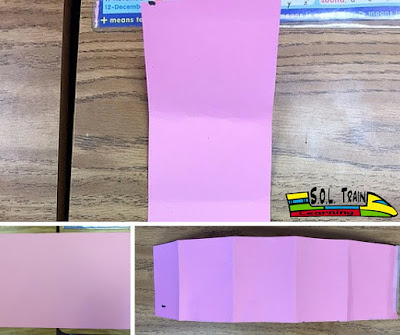Hello There!
As it is the middle of Spring, I'm guessing you're in one of two places: 1)
Dear Lord, will this testing ever end?? 2)
Dear Lord, how many days until summer again? Either way, you're exhausted, doing 1000 things at once, and praying your students don't drive you into the looney bin. Wanna know one of the best things you can do to curb this insanity?
Centers. It's true. The more independently your students work, the more it frees time for you to either work on your never-ending to-do list, or focus on students who need extra support. In my previous post
Who, What, When, Where, Why and How of Learning Centers, I address three different center elements: Enrichment, Skill, and Exploratory. The best way to enhance your students' learning experience, is to focus on a primary element and incorporate the other two as secondary elements. In this post, I'm addressing Skill as the primary element because I know many of you focus on standards-based learning.
According to
Teachervision.com, a Skill-based center is exactly as it sounds. It is a center that focuses on a particular learning skill. For example, a reading skill center might involve leveled readers, or a certain reading skill process. A writing center might involve a prompt or journal of some kind. Here are some skill-based centers and tips for stepping up your game with Enrichment and Exploratory elements:
English Language Arts(ELA)
Read It, Build It, Write It: This activity involves a space for reading the word, building the word with either magnets, stamps, stickers, etc, and writing the word on lined paper. You can purchase sheets like this on various teacher websites or make your own. Here's one by one of my esteemed teaching associate's:
CVC Word Building Cards Bundle
Enrichment: We will use Earth Day as an example. Rather than using sight words, use vocabulary that focuses on Earth Day. We have numerous Daily Concept Builders™ resources that do this very thing. You can use the cards from our
calendar or
memory game, or write your own Earth Day vocabulary.
Pam also uses our Daily Concept Builders ELA Books in a center. Her students highlight words that are introduced from our Calendar. The books are also a song so they love to sing the words! There are also questions to answer in the back of the books.
This is the Earth Day book that she is using:
Exploratory: Rather than just writing the word, encourage students to use it in a sentence. You can differentiate according to each student's level. Encourage your struggling writers to draw a picture.
Read the Room: Students walk around the room with pointers of some kind, finding words they recognize and writing them on a piece of paper. This bundle by
Jennifer Drake, allows you to edit your words, and it contains different themes! You can also use the cards from our calendar or memory game.
Enrichment: Again, use Earth Day vocabulary words.
Exploratory: Have students look purposefully for a handful of words that go together. This works great with our
Daily Concept Builders™ resources at the end of the month, because each month contains words that surround a theme. Students can look for 3-5 related words, then use them in a sentence.
Writing: This one is pretty self-explanatory. Students
write, either in a notebook, on writing paper, printer paper, or any other type of paper, either freely or using a prompt.
Enrichment: Provide open assignments or writing prompts based on your theme.
Exploratory: Give students a variety of options regarding final writing product. You can encourage them to publish their books or do something out of the box like a scrapbook page or greeting card. Maybe they can write a letter or if you have the means, encourage them to type a blog post. Provide different writing materials like pens, markers, colored pencils, and different embellishments like stamps and stickers.
Earth Day Sight Words: This is a center we've created that incorporates all three elements. Students match letter manipulatives to each letter in each sight word. It is Earth Day themed, so you can talk about how the cards relate to Earth Day. For example:
As you can see, the children in the pictures are holding recycling bins. Ask your students what the children are holding. Then ask them to recall what recycling is. Ask them why the letters are on plastic jugs. It is because we recycle plastic jugs. What are some other things we do to preserve the Earth?
To incorporate the exploratory element, simply have them choose one or two sight words and write a sentence about Earth Day.
Math
Real Life Problem: Create a problem that students have to solve. The problem should have multiple components that not only require group thinking, but provide for multiple outcomes and incorporate multiple math skills.
Enrichment: Make the problem Earth-Day themed. Place two pieces of computer paper on the table. Tell students that each of them must use the paper given to answer the questions you've provided. In order to
reduce waste, they are not allowed to ask for any additional paper.
Exploratory: Let's say there are 5 students. They can decide to tear the paper or maybe they'll share the space. This part will be completely individualized because you give your students the opportunity to solve the problem in their own way. Here are some questions you can ask:
1) How many pieces of paper are there? Skill-Counting
2) How many students are there? Skill-Counting
3) How many more pieces of paper do you need? Skill-Subtraction
4) How will you use the paper on the table so everyone gets to write on it? Skill-Problem Solving
If you want to incorporate addition, ask them to answer questions 1-4 given the stipulation that 2 friends join their group.
Computer: There are a number of great Math games on the computer.
Enrichment:
Primarygames.com has some great Earth-Day themed games
Exploratory: They choose which game they want to play.
Themed games: There are a number of games you can purchase on various teacher websites that focus on math skills with a fun theme. While we don't have any Earth Day themed Math games, we do have a number of other themed
Math games. Using the same discussion method I outlined in the Earth Day Sight Words example, you can incorporate your unit focus into any of these games.
Earth Day Math Centers by First Grade Kate has some cute themed games.
Blocks or Legos: Have students create something out of shape blocks (like Tangrams) or legos that accompanies your Earth Day theme. Here are some creations Pam's kiddos have come up with. They are not related to the theme, but still very cool.
Math centers are definitely trickier when it comes to incorporating multiple elements. A great way to incorporate the Exploratory element into a Math center is to encourage students to represent their learning using their own method. I outline this a little more clearly in the post
3 Steps to Easy Comprehension for All Learners. Ask them to represent equations with their media of choice. They can draw, use playdough, use blocks, whatever they like. You can make it Earth Day themed by providing silk flowers or globe erasers to use.
So, the next time you do centers, think about how you can incorporate multiple elements to make them as productive as possible. Your students are maximizing each learning moment and you get to take a step back to watch them succeed. Stay tuned for a Fun Friday Earth Day activity!
Like this post?
PIN IT!
Have a great week,

 This is a fantastic and fun idea by Soaring Through Second. Create a backdrop, have kiddos write why they love mom on a white board, and take pictures. You can add goofy props, costumes, or maybe a craft. If you have extra cash, have it printed on something to create a longer lasting memory for mom.
This is a fantastic and fun idea by Soaring Through Second. Create a backdrop, have kiddos write why they love mom on a white board, and take pictures. You can add goofy props, costumes, or maybe a craft. If you have extra cash, have it printed on something to create a longer lasting memory for mom. What better way to say "I love you" than a practical gift made with love? This idea from Life with Lovebugs is adorable, quick, and relatively inexpensive. Not to mention, you can differentiate based on age. For example, use washi tape for young ones, or stickers, or other adhesive. You can write their name and date in thin Sharpie on the side as a mom keepsake. For older kids, get some thin markers and have them decorate the clothespins themselves. You can get 100 from Michael's for about $3. Divide them accordingly and here's the best part: rather than wrap the clothespins, have kiddos clip them to a Mother's Day card. Cute right? In case you're wondering why clothespins are a good idea, think about all the ways you could use some. One use in particular is to keep snack bags closed as pictured on the Life with Lovebugs website.
What better way to say "I love you" than a practical gift made with love? This idea from Life with Lovebugs is adorable, quick, and relatively inexpensive. Not to mention, you can differentiate based on age. For example, use washi tape for young ones, or stickers, or other adhesive. You can write their name and date in thin Sharpie on the side as a mom keepsake. For older kids, get some thin markers and have them decorate the clothespins themselves. You can get 100 from Michael's for about $3. Divide them accordingly and here's the best part: rather than wrap the clothespins, have kiddos clip them to a Mother's Day card. Cute right? In case you're wondering why clothespins are a good idea, think about all the ways you could use some. One use in particular is to keep snack bags closed as pictured on the Life with Lovebugs website.  We posted this one last week on our blog. You can combine Earth Day awareness with a cute Mother's Day gift. Read more HERE.
We posted this one last week on our blog. You can combine Earth Day awareness with a cute Mother's Day gift. Read more HERE.













































